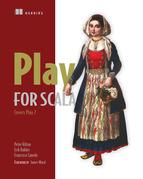Book Description
Summary
Play for Scala shows you how to build Scala-based web applications using the Play 2 framework. This book starts by introducing Play through a comprehensive overview example. Then, you'll look at each facet of a typical Play application both by exploring simple code snippets and by adding to a larger running example. Along the way, you'll deepen your knowledge of Scala as a programming language and work with tools like Akka.
About this Book
Play is a Scala web framework with built-in advantages: Scala’s strong type system helps deliver bug-free code, and the Akka framework helps achieve hassle-free concurrency and peak performance. Play builds on the web’s stateless nature for excellent scalability, and because it is event-based and nonblocking, you’ll find it to be great for near real-time applications.
Play for Scala teaches you to build Scala-based web applications using Play 2. It gets you going with a comprehensive overview example. It then explores each facet of a typical Play application by walking through sample code snippets and adding features to a running example. Along the way, you’ll deepen your knowledge of Scala and learn to work with tools like Akka.
Written for readers familiar with Scala and web-based application architectures. No knowledge of Play is assumed.
What’s Inside
Intro to Play 2
Play’s MVC structure
Mastering Scala templates and forms
Persisting data and using web services
Using Play’s advanced features
About the Authors
Peter Hilton, Erik Bakker, and Francisco Canedo are engineers at Lunatech, a consultancy with Scala and Play expertise. They are contributors to the Play framework.
